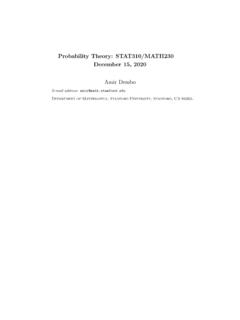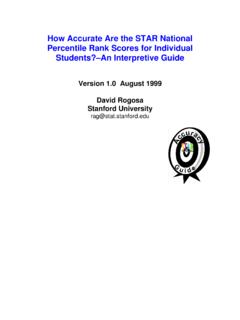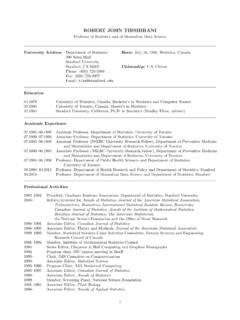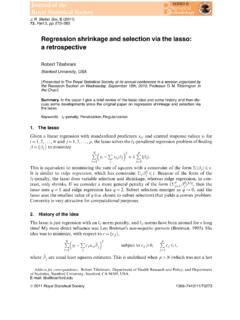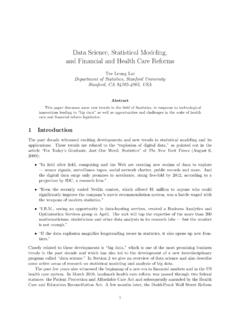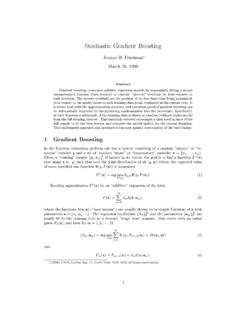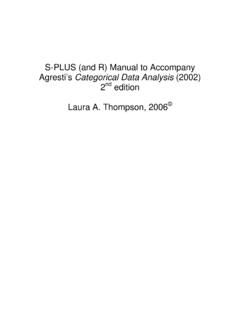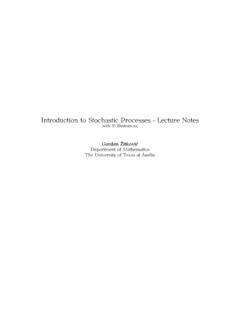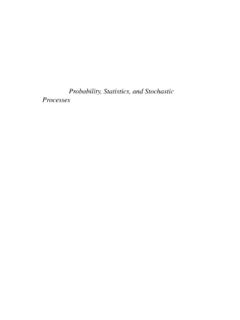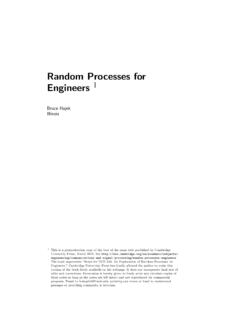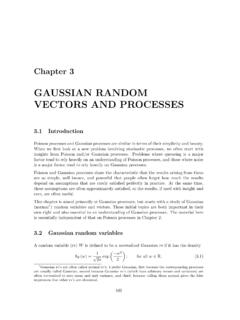Transcription of Stochastic Processes - Stanford University
1 Stochastic ProcessesAmir Dembo (revised by Kevin Ross)August 21, 2013E-mail of Statistics, Stanford University , Stanford ,CA 1. probability , measure and probability spaces and random variables and their Convergence of random Independence, weak convergence and uniform integrability25 Chapter 2. Conditional expectation and Hilbert Conditional expectation: existence and Hilbert Properties of the conditional Regular conditional probability46 Chapter 3. Stochastic Processes : general Definition, distribution and Characteristic functions, Gaussian variables and Sample path continuity62 Chapter 4.
2 Martingales and stopping Discrete time martingales and Continuous time martingales and right continuous Stopping times and the optional stopping Martingale representations and Martingale convergence Branching Processes : extinction probabilities90 Chapter 5. The Brownian Brownian motion: definition and The reflection principle and Brownian hitting Smoothness and variation of the Brownian sample path103 Chapter 6. Markov, Poisson and Jump Markov chains and Poisson process, Exponential inter-arrivals and order Markov jump Processes , compound Poisson processes125 Bibliography127 Index1293 PrefaceThese are the lecture notes for a one quarter graduate course inStochastic Pro-cesses that I taught at Stanford University in 2002 and 2003.
3 Thiscourse is intendedfor incoming master students in Stanford s Financial Mathematics program, for ad-vanced undergraduates majoring in mathematics and for graduate students fromEngineering, Economics, Statistics or the Business school. One purpose of this textis to prepare students to a rigorous study of Stochastic Differential Equations. Morebroadly, its goal is to help the reader understand the basic concepts of measure the-ory that are relevant to the mathematical theory of probability and how they applyto the rigorous construction of the most fundamental classes ofstochastic this goal, we introduce in Chapter 1 the relevant elements from measureand integration theory, namely, the probability space and the -fields of eventsin it, random variables viewed as measurable functions, their expectation as thecorresponding Lebesgue integral, independence, distribution andvarious notions ofconvergence.
4 This is supplemented in Chapter 2 by the study of theconditionalexpectation, viewed as a random variable defined via the theory of orthogonalprojections in Hilbert this exploration of the foundations of probability Theory, weturn in Chapter3 to the general theory of Stochastic Processes , with an eye towards processesindexed by continuous time parameter such as the Brownian motion of Chapter5 and the Markov jump Processes of Chapter 6. Having this in mind, Chapter3 is about the finite dimensional distributions and their relation to sample pathcontinuity. Along the way we also introduce the concepts of stationary and Gaussianstochastic 4 deals with filtrations, the mathematical notion of information pro-gression in time, and with the associated collection of Stochastic Processes calledmartingales.
5 We treat both discrete and continuous time settings,emphasizing theimportance of right-continuity of the sample path and filtration in the latter representations are explored, as well as maximal inequalities, conver-gence theorems and applications to the study of stopping times andto extinctionof branching 5 provides an introduction to the beautiful theory of theBrownian mo-tion. It is rigorously constructed here via Hilbert space theory andshown to be aGaussian martingale process of stationary independent increments, with continuoussample path and possessing the strong Markov property. Few of the many explicitcomputations known for this process are also demonstrated, mostly in the contextof hitting times, running maxima and sample path smoothness and 6 provides a brief introduction to the theory of Markov chains and pro-cesses, a vast subject at the core of probability theory, to whichmany text booksare devoted.
6 We illustrate some of the interesting mathematical properties of suchprocesses by examining the special case of the Poisson process, and more generally,that of Markov jump clear from the preceding, it normally takes more than a year to cover the scopeof this text. Even more so, given that the intended audience for this course has onlyminimal prior exposure to Stochastic Processes (beyond the usual elementary prob-ability class covering only discrete settings and variables with probability densityfunction). While students are assumed to have taken a real analysis class dealingwith Riemann integration, no prior knowledge of measure theory is assumed unusual solution to this set of constraints is to provide rigorous definitions,examples and theorem statements, while forgoing the proofs of allbut the mosteasy derivations.
7 At this somewhat superficial level, one can covereverything in aone semester course of forty lecture hours (and if one has highly motivated studentssuch as I had in Stanford , even a one quarter course of thirty lecture hours mightwork).In preparing this text I was much influenced by Zakai s unpublished lecture notes[Zak]. Revised and expanded by Shwartz and Zeitouni it is used to this dayforteaching Electrical Engineering Phd students at the Technion, Israel. A secondsource for this text is Breiman s [Bre92], which was the intended text book for myclass in 2002, till I realized it would not do given the preceding constraints.
8 Theresulting text is thus a mixture of these influencing factors with some digressionsand additions of my thank my students out of whose work this text materialized. Mostnotably Ithank Nageeb Ali, Ajar Ashyrkulova, Alessia Falsarone and Che-Lin Su who wrotethe first draft out of notes taken in class, Barney Hartman-Glaser, Michael He,Chin-Lum Kwa and Chee-Hau Tan who used their own class notes a year later ina major revision, reorganization and expansion of this draft, and Gary Huang andMary Tian who helped me with the intricacies of am much indebted to my colleague Kevin Ross for providing many of the exercisesand all the figures in this text.
9 Kevin s detailed feedback on an earlierdraft of thesenotes has also been extremely helpful in improving the presentationof many DemboStanford, CaliforniaJanuary 2008 CHAPTER 1 probability , measure and integrationThis chapter is devoted to the mathematical foundations of probability introduces the basic measure theory framework, namely, the proba-bility space and the -fields of events in it. The next building block are randomvariables, introduced in Section as measurable functions 7 X( ). This allowsus to define the important concept of expectation as the corresponding Lebesgueintegral, extending the horizon of our discussion beyond the special functions andvariables with density, to which elementary probability theory is limited.
10 As muchof probability theory is about asymptotics, Section deals with various notionsof convergence of random variables and the relations between them. Section the chapter by considering independence and distribution, the two funda-mental aspects that differentiate probability from (general) measure theory, as wellas the related and highly useful technical tools of weak convergence and probability spaces and -fieldsWe shall define here the probability space ( ,F,P) using the terminology of mea-sure theory. Thesample space is a set of all possible outcomes of somerandom experiment or phenomenon.
